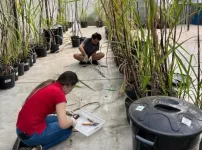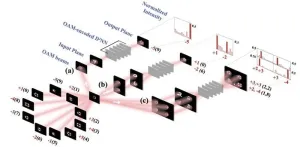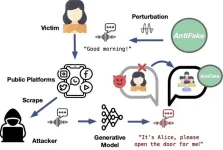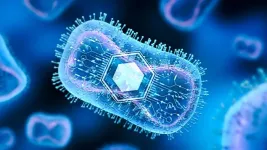(Press-News.org)
To reach the world’s goal of carbon neutrality by 2050, there must be a fundamental change in electronic materials to create a more reliable and resilient electricity grid. A diamond might be a girl’s best friend, but it might also be the solution needed to sustain the electrification of society needed to reach carbon neutrality in the next 30 years. Researchers at the University of Illinois Urbana-Champaign have developed a semiconductor device made using diamond, that has the highest breakdown voltage and lowest leakage current compared to previously reported diamond devices. Such a device will enable more efficient technologies needed as the world transitions to renewable energies.
It is estimated that currently, 50% of the world’s electricity is controlled by power devices, and in less than a decade, it is expected that that number will increase to 80%, while simultaneously, the demand for electricity will increase by 50% by 2050.
According to a new report from the National Academies of Sciences, Engineering, and Medicine, “Perhaps the single greatest technological danger to a successful energy transition is the risk that the nation fails to site, modernize, and build out the electrical grid. Without increased transmission capacity, renewables deployment would be delayed, and the net result could be at least a temporary increase in fossil fuel emissions, preventing the nation from achieving its emission reduction goals.”
“To meet those electricity demands and modernize the electrical grid, it’s very important that we move away from conventional materials, like silicon, to the new materials that we are seeing being adopted today like silicon carbide and the next generation of semiconductors—ultra-wide bandgap materials—such as aluminum nitride, diamond and related compounds,” says electrical and computer engineering professor Can Bayram, who led this research, along with graduate student Zhuoran Han. The results of this work were published in the journal IEEE Electron Device Letters.
Beyond silicon
Most semiconductors are built using silicon and thus far, have met society’s electrical needs. But as Bayram points out, “We want to make sure that we have enough resources for everyone, while our needs are evolving. Right now, we are using more and more bandwidth, we are creating more data (that also comes with more storage), and we are using more power, more electricity and more energy in general. The question is: is there a way we can make all of this more efficient, rather than generating more energy and building more power plants?”
Why diamond?
Diamond is an ultra-wide gap semiconductor with the highest thermal conductivity, which is the ability of a material to transfer heat. Due to these properties, diamond semiconductor devices can operate at much higher voltages and currents (with less material) and will still dissipate the heat without causing a reduction in electrical performance, compared to traditional semiconductor materials like silicon. “To have an electricity grid where you need high current and high voltage, which makes everything more efficient for applications such as solar panels and wind turbines, then we need a technology that has no thermal limit. That’s where diamond comes in,” Bayram says.
Although many people associate diamond with expensive jewelry, diamond can be made more affordably and sustainably in the lab, making it a viable and important semiconductor alternative. Natural diamond is formed deep below Earth’s surface under immense pressure and heat, but since it is essentially just carbon—of which there is an abundance of—artificially synthesized diamond can be made in weeks rather than billions of years, while also producing 100 times less carbon emissions.
In this work, Bayram and Han show that their diamond device can sustain high voltage, approximately 5 kV, although the voltage was limited by setup of measurement and not from the device itself. In theory, the device can sustain up to 9 kV. This is the highest voltage reported for a diamond device. Besides the highest breakdown voltage, the device also demonstrates the lowest leakage current, which can be thought of like a leaking faucet but with energy. Leakage current affects the overall efficiency and reliability of the device.
Han says, “We built an electronic device better suited for high power, high voltage applications for the future electric grid and other power applications. And we built this device on an ultra-wide bandgap material, synthetic diamond, which promises better efficiency and better performance than current generation devices. Hopefully, we will continue optimizing this device and other configurations so that we can approach the performance limits of diamond’s material potential.”
*
Can Bayram is also an affiliate of the Holonyak Micro and Nano Technology Laboratory at UIUC.
END
Next generation semiconductors: Diamond device shows highest breakdown voltage
2023-11-27
ELSE PRESS RELEASES FROM THIS DATE:
Review article shows key role of Brazil in research on sugarcane for bioenergy
2023-11-27
Publications on sugarcane have increased exponentially since 2006 worldwide, and Brazil has had more articles published on the topic than any other country in the period, according to a review in BioEnergy Research.
The number of articles on the subject averaged about five per year between 1999 and 2006 but had reached 327 by 2021. Brazil has twice as many articles on sugarcane as the United States, which ranks first in the world for scientific publications in general. Brazil is also ahead of Australia, China and India, which are also major sugarcane growers.
According to the authors of the review, who are affiliated with the Laboratory of Plant Physiological Ecology (LAFIECO) ...
Cellular postal service delivers messages from non-human cells, too
2023-11-27
Messenger bubbles produced by human cells can pick up bacterial products and deliver them to other cells, University of Connecticut researchers report in the Nov. 16 issue of Nature Cell Biology. The discovery may explain a key mechanism by which bacteria, whether friendly or infectious, affect our health.
Extra-cellular vesicles (EVs) are like a postal service for our cells. Cells produce the EVs, tiny bubbles with a water-resistant shell made of fatty substances called lipids, and send them into the bloodstream. When another cell comes across an EV, it takes it inside itself ...
Orbital-angular-momentum-encoded diffractive networks for object classification tasks
2023-11-27
Deep learning has revolutionized the way we perceive and utilize data. However, as datasets grow and computational demands increase, we need more efficient ways to handle, store, and process data. In this regard, optical computing is seen as the next frontier of computing technology. Rather than using electronic signals, optical computing relies on the properties of light waves, such as wavelength and polarization, to store and process data.
Diffractive deep neural networks (D2NN) utilize various properties of light waves to perform tasks like image and object recognition. Such networks consist of two-dimensional pixel arrays as diffractive layers. Each pixel serves as an adjustable ...
Gig workers saw greater financial hardship during COVID-19 compared to other workers
2023-11-27
Many gig workers experienced financial hardships during the COVID-19 pandemic, including food insecurity and trouble paying bills, according to a recent study published in Work and Occupations.
“In a nutshell, our study shows gig workers were harmed more by the COVID-19 pandemic than any other workers,” said Dr. Mathieu Despard, a co-author on the paper and faculty member in UNC Greensboro’s Department of Social Work.
Despard – who collaborated closely with first author Daniel Auguste ...
CU Anschutz scientists create patch that may successfully treat congenital heart defects
2023-11-27
AURORA, Colo. (Nov. 27, 2023) – Using laboratory engineered tissue, scientists at the University of Colorado Anschutz Medical Campus have created a full thickness, biodegradable patch that holds the promise of correcting congenital heart defects in infants, limiting invasive surgeries and outlasting current patches.
The findings were published this week in the journal Materials Today.
“The ultimate goal is to make lab-grown heart tissue from a patient’s own cells that can be used to restructure the heart to correct for heart defects,” said the ...
Defending your voice against deepfakes
2023-11-27
Recent advances in generative artificial intelligence have spurred developments in realistic speech synthesis. While this technology has the potential to improve lives through personalized voice assistants and accessibility-enhancing communication tools, it also has led to the emergence of deepfakes, in which synthesized speech can be misused to deceive humans and machines for nefarious purposes.
In response to this evolving threat, Ning Zhang, an assistant professor of computer science and engineering at the McKelvey School of Engineering at Washington University ...
Revolutionizing cancer treatment through programmable bacteria
2023-11-27
What if a single one-dollar dose could cure cancer?
A multi-university team of researchers, supported by federal funding, is developing a highly efficient bacterial therapeutic to target cancer more precisely to make treatment safer through a single $1 dose.
Traditionally, cancer therapies have been limited in their efficacy in treating patients. Some, like radiation and chemotherapy, cause harmful side effects, while others tend to result in low patient responsiveness, not to mention the cost it takes to receive treatment. Findings from the American Cancer Society Cancer Action Network recorded ...
One protein is key to the spread of lung cancer. Now, a new study has found a way to stop it
2023-11-27
A new study by Tulane University has uncovered a previously unknown molecular pathway that could be instrumental to halting lung cancer in its tracks.
Lung cancer is one of the most common cancers and the leading cause of cancer-related deaths in the world. The research, published in the journal Proceedings of the National Academy of Sciences, could lead to the development of a new anti-cancer drug and more personalized lung cancer treatment, said senior study author Dr. Hua Lu, the Reynolds and Ryan Families Chair in Translational Cancer at the Tulane University School of Medicine.
The study found ...
Study: Spike in premature births caused by COVID, halted by vaccines
2023-11-27
MADISON, Wis. — COVID-19 caused an alarming surge in premature births, but vaccines were key to returning the early birth rate to pre-pandemic levels, according to a new analysis of California birth records.
“The effect of maternal COVID infection from the onset of the pandemic into 2023 is large, increasing the risk of preterm births over that time by 1.2 percentage points,” says Jenna Nobles, a University of Wisconsin–Madison sociology professor. “To move the needle on preterm birth that much is akin to a disastrous ...
Why does puberty trigger us to stop growing?
2023-11-27
All animals start out as a single-celled organism and then start growing. At some point, of course, they need to stop getting bigger, but the process by which this happens is poorly understood.
New research from Alexander Shingleton at the University of Illinois Chicago and colleagues identifies a potential trigger that makes fruit flies stop growing, which has implications for understanding human development. The research is published in the Proceedings of the National Academy of Sciences.
In humans, the body’s signal to stop growing happens around puberty, though it takes several more years before growth actually ceases. It is important to better ...



